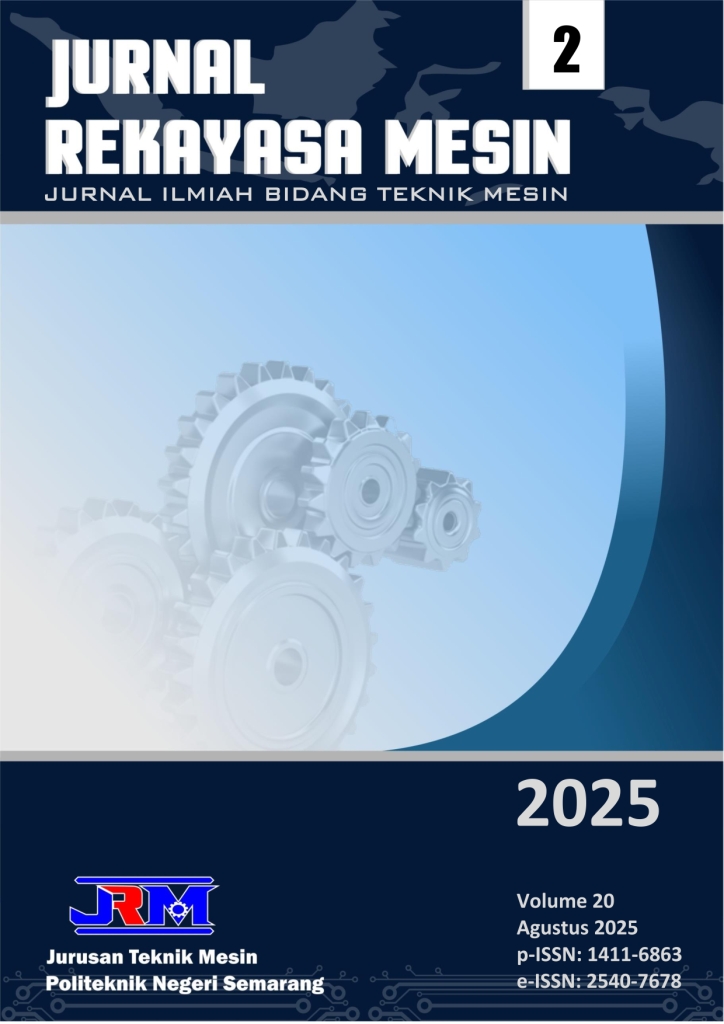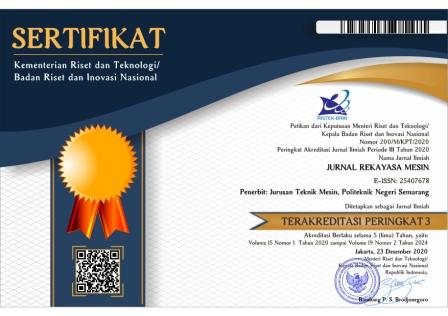Optimization Design of NACA 4412 Airfoil Based on Genetic Algorithm for Efficiency and Maximum Lift Force
DOI:
https://doi.org/10.32497/jrm.v20i2.6531Keywords:
airfoil, genetic algorithm, gurney flap, internal slotAbstract
The NACA 4412 airfoil, renowned for its exceptional subsonic aerodynamic performance, faces critical operational constraints including elevated drag characteristics and premature stall onset at high angles of attack. While previous investigations have independently examined internal slot modifications and gurney flap implementations for aerodynamic enhancement, the synergistic potential of their combined application to the NACA 4412 configuration remains largely unexplored. This research presents a comprehensive optimization study that strategically integrates internal slot geometry with gurney flap configuration to maximize lift coefficient (CL) and aerodynamic efficiency (CL/CD) through advanced genetic algorithm optimization. The methodology employed high-fidelity computational fluid dynamics simulations using FLUENT with Spalart-Allmaras turbulence modeling, validated against experimental data to ensure accuracy. PCHIP numerical interpolation techniques were utilized to estimate aerodynamic coefficients across comprehensive angle-of-attack ranges not directly simulated. The optimized configuration demonstrated remarkable performance improvements, including a 75.68% increase in lift coefficient, an extension of the critical stall angle from 14° to 16°, enhanced aerodynamic efficiency, and significantly improved flow stability with reduced separation characteristics. These findings establish that the synergistic combination of internal slot and gurney flap modifications can fundamentally transform NACA 4412 aerodynamic performance, particularly excelling in high-angle-of-attack operational scenarios.
References
[1] Rayhan AM, Hossain MS, Mim RH, et al. Computational and experimental study on the aerodynamic performance of NACA 4412 airfoil with slot and groove. Heliyon; 10. Epub ahead of print 15 June 2024. DOI: 10.1016/j.heliyon.2024.e31595.
[2] saxena G, agrawal M. Aerodynamic analysis of NACA 4412 airfoil using CFD. Int J Emerg Trends Eng Dev Issue; 3.
[3] Ni Z, Dhanak M, Su T chow. Improved performance of a slotted blade using a novel slot design. J Wind Eng Ind Aerodyn 2019; 189: 34–44.
[4] Chandra S, Tyagi R. Study of Eppler 423 Airfoil with Gurney Flap and Vortex Generators. Adv Aerosp Sci Technol 2020; 05: 1–19.
[5] Bahatmaka A, Kim DJ, Chrismianto D, et al. Optimization of thrust propeller design for an ROV (Remotely Operated Vehicle) consideration by Genetic Algorithms. MATEC Web Conf; 138. Epub ahead of print 2017. DOI: 10.1051/matecconf/201713807003.
[6] Bahatmaka A, Kim DJ, Anis S. A Validation Simulation using OpenFOAM: Nozzle Length and Angle Effect on the Ducted Propeller Performance. IOP Conf Ser Earth Environ Sci; 1083. Epub ahead of print 2022. DOI: 10.1088/1755-1315/1083/1/012088.
[7] Aftab SMA, Ahmad KA. CFD study on NACA 4415 airfoil implementing spherical and sinusoidal Tubercle Leading Edge. PLoS One 2017; 12: 1–27.
[8] Anil Kumar B, Manjunath S, Ganganna R. Computational Investigation of Flow Separation in Incompressible Aerodynamic Regime. Int J Innov Res Sci Eng Technol (An ISO 2007; 3297: 470–476.
[9] Karthikeyan K V., Harish R. Enhanced aerodynamic performance of NACA4412 airfoil through integrated plasma actuator and Gurney flap flow control. Results Eng; 25. Epub ahead of print 2025. DOI: 10.1016/j.rineng.2025.103977.
[10] Bode F, Joldos T, Sirbu GM, et al. Impact of realistic boundary conditions on CFD simulations: A case study of vehicle ventilation. Build Environ 2025; 267: 112264.
[11] Lu S, Liu J, Hekkenberg R. Mesh properties for rans simulations of airfoil-shaped profiles: A case study of rudder hydrodynamics. J Mar Sci Eng; 9. Epub ahead of print 2021. DOI: 10.3390/jmse9101062.
[12] Akram MT, Kim MH. CFD analysis and shape optimization of airfoils using class shape transformation and genetic algorithm—part i. Appl Sci; 11. Epub ahead of print 2021. DOI: 10.3390/app11093791.
[13] Suprayitno, Yu JC, Aminnudin, et al. Airfoil aerodynamics optimization under uncertain operating conditions. J Phys Conf Ser; 1446. Epub ahead of print 2020. DOI: 10.1088/1742-6596/1446/1/012014.
[14] Julian J, Iskandar W, Wahyuni F. Aerodynamics Improvement of NACA 0015 by Using Co-Flow Jet. Int J Mar Eng Innov Res; 7. Epub ahead of print 2022. DOI: 10.12962/j25481479.v7i4.14898.
[15] Wang Y, Shimada K, Barati Farimani A. Airfoil GAN: encoding and synthesizing airfoils for aerodynamic shape optimization. J Comput Des Eng 2023; 10: 1350–1362.
[16] Popov AV, Botez RM, Labib M. Transition point detection from the surface pressure distribution for controller design. J Aircr 2008; 45: 23–28.
[17] Hassan A. Predicted Aerodynamic Characteristics of a NACA 0015 Airfoil Having a 25% Integral-type Trailing Edge Flap. Nasa Tech Pap; CR-1999-20.
[18] Goldberg_Genetic_Algorithms_in_Search.pdf. Canada: Addison-Wesley Publishing Company, Inc.
[19] Tyagi A, Singh P, Rao A, et al. A novel framework for optimizing Gurney flaps using RBF surrogate model and cuckoo search algorithm. Acta Mech 2024; 235: 3385–3404.
[20] Lee M, Park G, Park C, et al. Improvement of Grid Independence Test for Computational Fluid Dynamics Model of Building Based on Grid Resolution. Adv Civ Eng; 2020. Epub ahead of print 2020. DOI: 10.1155/2020/8827936.
[21] NASA. Bernoulli ’ s Principle principles of flight. Museum BOX 2010; 38 pages.
Downloads
Published
How to Cite
Issue
Section
License
Copyright (c) 2025 Aryo Eko Laksono, Aldias Bahatmaka, Deni Fajar Fitriyana, Galih Tri Laksono, Muhammad Habibullah, Haris Nubli, Cho Joung Hyung

This work is licensed under a Creative Commons Attribution-NonCommercial-ShareAlike 4.0 International License.
Copyright of articles that appear in Jurnal Rekayasa Mesin belongs exclusively to Penerbit Jurusan Teknik Mesin Politeknik Negeri Semarang. This copyright covers the rights to reproduce the article, including reprints, electronic reproductions, or any other reproductions of similar nature.







